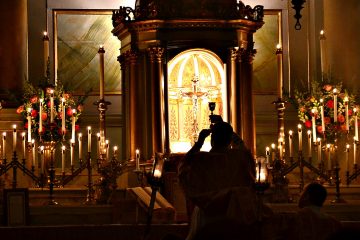Catholic Energies looks to help church organizations go green

IMAGE: CNS photo/Dennis Sadowski
By Dennis Sadowski
CINCINNATI (CNS) — Entering her classroom at St. Teresa of Avila School in Cincinnati to prepare for the start of the new academic year, art teacher Cheryl Cannon saw things in a new light.
Brighter colors. Fewer shadows. A cheerier environment.
The new LED lights are great, she thought.
“The kids can see what they’re doing now,” Cannon told Catholic News Service on the first day of classes Aug. 17.
Throughout the school — from the front office, to the halls and into the classrooms — the new light-emitting diode bulbs gained the approval of teachers, students and staff.
Replacing bulbs across the campus of St. Teresa of Avila Parish is part of an overall effort to reduce energy consumption, in part under the Catholic Energies program developed by the Catholic Climate Covenant.
Bill Thoman, parish property manager, said the parish wanted to be part of the program in response to Pope Francis’ call to care for God’s creation in his 2015 encyclical, “Laudato Si’, on Care for Our Common Home.”
“That really plays into (the idea), ‘Look, guys, this is not something we’re making up. We need to take a couple steps back and really look at what we’re doing to poor Mother Earth. We’re beating her up,'” Thoman said of the parish’s long involvement in reducing energy consumption, using clean energy, boosting recycling and encouraging responsibility and sustainability in the use of natural resources.
The parish continued to install energy-efficient LED lightbulbs in buildings throughout the fall. Other steps across parish grounds have seen the installation of suspended, or dropped, ceilings in the school so that less space in the rooms must be heated and cooled; the remodeling of school computer labs, adding central air conditioning as needed; and the installation of high-efficiency boilers for the heating system.
With the cost of LED lights substantially dropping during the past two years, they have become a worthwhile option for building owners.
Thoman said the conversion isn’t inexpensive, but that it’s a good investment because the money spent will be recovered in a few years through lower energy costs. The parish has undertaken fundraisers to pay for some of the upgrades and secured private financing for others.
Catholic Energies was developed to complement the Catholic Climate Covenant’s education and advocacy work. Dan Last, Catholic Energies chief operating office, said the program emerged in 2016 from hundreds of conversations with pastors, parish staff members and organizational leaders about the need for practical steps on behalf of the environment.
Catholic parishes, schools, hospitals, nursing homes and other organizations operate an estimated 70,000 buildings, most of which use energy inefficiently, wasting about $1 billion a year, Last told CNS. Reducing energy usage by 25 percent in those buildings would save $630 million and 8.7 billion tons of coal, according to an estimate he prepared.
“Forty percent of energy use is wasted. The obvious place to go for maximum impact is to reduce energy consumption in facilities where people spend the most time. Then there are environmental benefits, less waste, less carbon, especially as most energy is produced by carbon sources,” said Last, who has worked in energy conservation for eight years.
Along the way, Catholic campuses can be a model of energy efficiency, he added.
The program involves working with local utility companies and energy providers to benchmark energy use, assess buildings and utilize programs an incentives to realize immediate savings. An organization wishing to take the next step and retrofit equipment, windows and lighting can enter a financing arrangement under which the money saved on energy bills is used pay back any borrowed money.
The program also will help entities determine how best to install solar panels or boost the use of energy from renewable sources, such as wind and biomass, which means getting energy from burning wood and other organic matter.
Dan Misleh, Catholic Climate Covenant executive director, said the program was developed in response to the pope’s encyclical and offers people a chance to find ways in their lives “to live more simply and in keeping with the resources of a finite planet.”
“People would rather do something positive than just hear negative news all the time. I think that’s particularly true with climate change,” Misleh told CNS. “People want to be able to do something about it and we’re providing the opportunity at the parish and school levels, and perhaps at universities and hospitals, to do something about it.”
The companies working under the program have been vetted by Catholic Energies, allowing building operators to know that the work will be done by certified contractors, Misleh added.
“We feel they’re (parishes) probably being inundated with proposals. We’ve done a lot of the legwork ahead of time, he said.
The Archdiocese of Cincinnati was chosen to pilot the program because of its broad commitment to energy conservation. After initial success, the program is ready to be rolled out nationwide.
Archdiocesan offices in downtown Cincinnati were remodeled in 2016 and 2017 with energy efficiency and lower energy costs in mind. Tony Stieritz, director of the archdiocese’s social action office, told CNS Pope Francis inspired church leaders to step up to do as much as possible to protect the environment.
“Fundamentally this is truly an effort to bring our values and teachings into life, to put our commitments to what our teaching is on caring for our creation,” Stieritz said.
“Everybody has a right to the good, the gift of the Earth because God made it. It has an inherent dignity and we have a responsibility to protect it,” he explained.
Catholic Energies was introduced to parish representatives in November. Seventy of 210 parishes attended that initial meeting. While four parishes are involved with Catholic Energies in some way, Last expressed hope that others will join as the program introduces new financing packages.
St. John Fisher Church in suburban Newtown is another parish with ties to the program. Jenifer Tiettmeyer, parish business manager, said the parish agreed with the program’s concept and joined the effort but secured its own financing for its improvements.
The parish recently installed a $40,000 heating, ventilating and air conditioning unit, replacing one that had been used since the 1970s, Tiettmeyer told CNS. LED lights have been installed in parish offices and the church, with 266 lights, was next for the conversion in the fall, she said.
Tiettmeyer projected savings on energy consumption to be enough to recover the cost of the updates in about three years.
“Any time we save money on something while maintaining quality,” she said, “it’s a good thing.”
Last said Catholic Energies focuses on developing market-based solutions that can have benefits for Catholic organizations.
“What if a school was able to spend less on utilities and spend more on education?” he asked.
“These projects work. They save energy. They save money.”
– – –
Editor’s Note: More information on Catholic Energies can be found online at https://catholicenergies.org.
– – –
Follow Sadowski on Twitter: @DennisSadowski.
– – –
Copyright © 2017 Catholic News Service/U.S. Conference of Catholic Bishops. www.catholicnews.com. All rights reserved. Republishing or redistributing of CNS content, including by framing or similar means without prior permission, is prohibited. You may link to stories on our public site. This copy is for your personal, non-commercial use only. To request permission for republishing or redistributing of CNS content, please contact permissions at [email protected].













